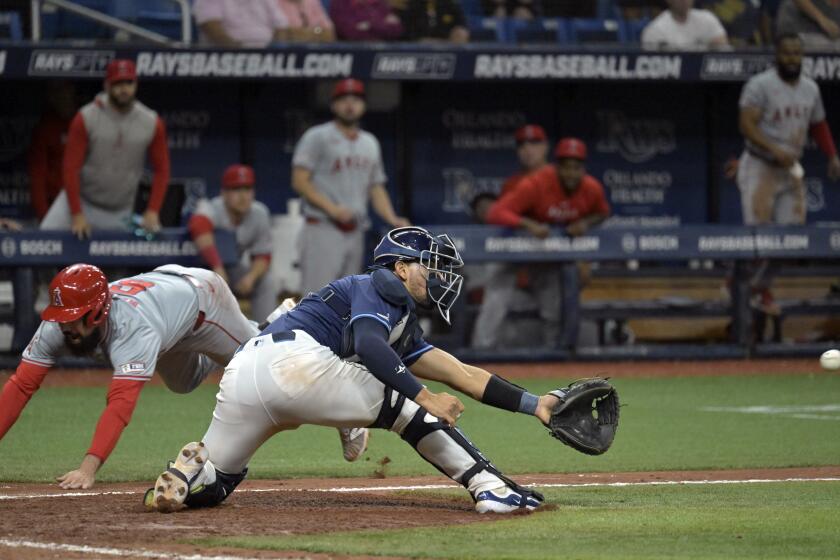Column: How Sherwin-Williams’ cute charity promotion at Angel Stadium turned into a PR problem
Frazee Paint, which is now owned by Sherwin-Williams, had a clever idea back in 2014 of how to look like a friend of philanthropy. Frazee placed a giant mock-up of a paint can in Angel Stadium just beyond the left-center field fence, along with a sign indicating it would contribute $1 million to the Angels Baseball Foundation any time an Angels batter parked a home run ball in the can.
Well, left-fielder Justin Upton did just that last Tuesday, in the ninth inning. That’s when it transpired that there was a catch all along: The ball had to enter the can on the fly. Upton’s homer ball bounced at least once before caroming into the can. So, no contribution.
Sherwin-Williams has taken a fair amount of heat for what looks like a hyper-technical quibble, ever since ESPN reported on the conditional nature of the donation. So let’s make a couple of things clear.
First, the deal always was that the ball had to land in the can on the fly. That was stated explicitly at the outset, when Frazee announced the promotion in 2014. Them’s the breaks.
Second: Really, Sherwin-Williams?
This is a company that earned a profit of more than $1.1 billion in 2016, on sales of nearly $12 billion. Upton could plunk 1,100 home run balls directly into the can before Sherwin-Williams could run out of money. As it happens, no ballplayer ever has hit more than 762 homers in a career or 73 in a season. (Both records are held by Barry Bonds of the San Francisco Giants.) So Sherwin-Williams’ profits are probably safe, no matter where his dingers land.
Sherwin-Williams referred my questions about the case to the Angels. Team spokesman Tim Mead said the team hadn’t made an issue of the donation, because it fully understood that a deal was a deal and Upton’s hit didn’t qualify. He says no one has landed a homer in the can on the fly since the promotion started in 2014, although Mike Trout did so during batting practice one time. (That didn’t trigger the donation either.) The Angels Baseball Foundation, Mead told me, is largely focused on programs for children, to which it’s donated about $3 million over the years.
This case points to a downside of what we’ve previously labeled cause-related marketing. The phenomenon is most commonly seen during the holiday season, when consumer companies try to enlist their customers in feel-good philanthropy by pledging to pay into a charitable kitty at a pace tied to customer purchases. American Express has even allowed customers to vote on which charities should get its largess.
Sports leagues like to show their devotion to this or that cause at various points during their seasons; Major League Baseball players brandished pink bats and wore pink ribbons earlier this season to signal its affiliation with the Susan G. Komen organization for breast cancer research. The (RED) Movement founded by Bono and Bobby Shriver co-markets consumer products colored bright red and receives a portion of the purchase price for AIDS research.
Yet all these schemes beg a fundamental question: If these companies and other donors recognize that the recipient organizations are worthy charities, why make their contributions conditional? American Express donated $39 million to global charities in 2015, the latest year for which I could find an accounting; that year, the company recorded $5.2 billion in profit. It isn’t clear how much of that was tied to specific action by its customers, but why should any of it derive from consumer activity? If American Express’ customers wish to donate to charity, they don’t need to wait for American Express to act as an intermediary.
So let’s call these campaigns what they are: Marketing ploys, dressed up as charity.
But they can backfire, as one might argue has happened with Sherwin-Williams. The company plainly has enough money to fork over $1 million to the Angels Baseball Foundation, especially since the donation surely would be tax-deductible. Linking it to the rare athletic achievement of a slugger pasting the ball just so only makes it seem as if the company is looking for a way out of making the donation at all — especially if it’s going to point to the narrow conditions of the gift so it can pay out nothing.
The Upton homer could have been an occasion for the company to look really generous. We wouldn’t want to tell Sherwin-Williams its business, but here’s a suggestion: Pay the money anyway. Unless, that is, you want to look cheap.
Keep up to date with Michael Hiltzik. Follow @hiltzikm on Twitter, see his Facebook page, or email michael.hiltzik@latimes.com.
Return to Michael Hiltzik’s blog.
More to Read
Go beyond the scoreboard
Get the latest on L.A.'s teams in the daily Sports Report newsletter.
You may occasionally receive promotional content from the Los Angeles Times.






